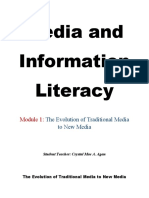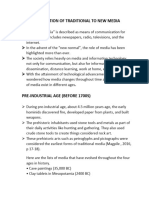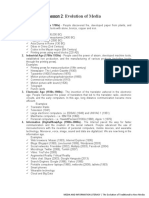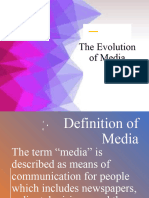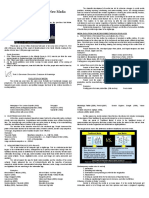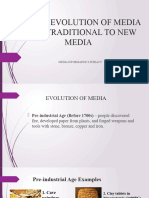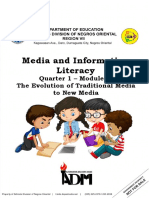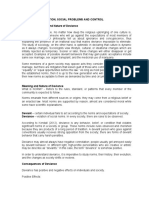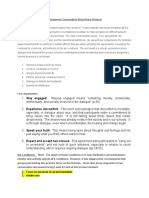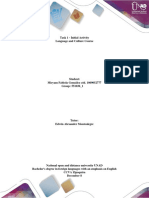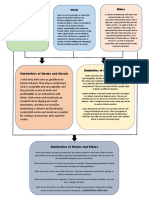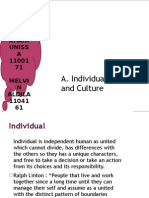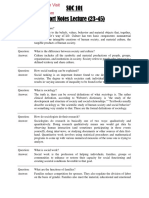What is It
The Evolution of Traditional to New Media
The term “media” is described as means of communication for people which
includes newspapers, radio, televisions, and the internet. In the advent of the “new
normal”, the role of media has been highlighted more than ever. The society relies
heavily on media and information technology, not only for communication, but also
for information dissemination, distance learning, work at home, etc. With the
attainment of technological advancement, people wondered how media changes
throughout time and what forms of media exist in different ages. To answer these
queries, let us now discover how media have evolved from pre-industrial age to
information age.
Pre-Industrial Age (Before 1700s)
During pre-industrial age, about 4.5
million years ago, the early hominids
discovered fire, developed paper from plants,
and built weapons (Teaching Guide for Senior
High School Media and Information Literacy,
p. 20). The prehistoric inhabitants used
stone tools and metals as part of their daily
activities like hunting and gathering. They
also used crude stone tools to create things
considered rock art. These prehistoric arts
such as petroglyphs and pictographs were
considered the earliest forms of traditional
media (Magpile , 2016, p 17-18). Figure 2: Cave Paintings in 13,000 B.C.
Image courtesy to: https://commons.wikimedia.
org/wiki/File:San_cave_painting__Phoenicean_sh
ip.jpg
Industrial Age (1700s - 1930s)
The industrial age occurs during the
industrial revolution in Great Britain. This
period brought in economic and societal
changes, such as the substitution of handy
tools with machines like the power loom and
the steam engine. The transformation of the
manufacturing industry, and commercial
enterprise for mass production of various
products occurred. Also, long-distance
communication became possible via
telegraph, a system used for transmitting
messages. (Magpile, 2016, p. 19-20) Figure 3: Printing Trades (1916)
Image courtesy to: https://commons.wiki
media.org/wiki/File:The_printing_trades_(1916)_
(14765737815).jpg
8
�Electronic Age (1930s - 1980s)
The electronic age started when people
utilized the power of electricity that made
electronic devices like transistor radio and
television work. The creation of the transistor
piloted the rise of the electronic age. The
power of transistors was used in radio,
electronic circuits, and early computers. In
this period, people made use of air access to
communication. (Teaching Guide for Senior Figure 4: Desktop Personal Computer
High School Media and Information Literacy, p. Image courtesy to: https://commons.wikimedia.
21) org/wiki/File:Desktop_personal_computer.jpg
Information Age (1900s - 2000s)
The information age is a period also
known as the digital age. This period signified
the use of the worldwide web through an
internet connection. Communication became
faster and easier with the use of social
networks or social media platforms such as
Facebook, Messenger, Instagram, Twitter,
among others. The rapid technological
advancement and innovation with the use of
microelectronics lead to the development of
laptops, netbooks mobile phones, and
wearable technology. (Teaching Guide for
Senior High School Media and Information Figure 5: Social Media Apps
Literacy, p. 21) Image courtesy to: https://commons.wikimedia.org/
wiki/ File:Socialmedia-pm.png
Here are the lists of media that have evolved throughout the four ages in
history.
Pre-Industrial Age (Before 1700s)
• Cave paintings (35,000 BC)
• Clay tablets in Mesopotamia (2400 BC)
• Papyrus in Egypt (2500 BC)
• Acta Diurna in Rome (130 BC)
• Dibao in China (2nd Century)
• Codex in the Mayan region (5th Century)
• Printing press using wood blocks (220 AD)
Industrial Age (1700s-1930s)
• Printing press for mass production (19th
century)
• Newspaper- The London Gazette (1640)
• Typewriter (1800) Telephone (1876)
• Motion picture photography/projection (1890)
• Commercial motion pictures (1913)
• Motion picture with sound (1926)
• Telegraph
9
� • Punch cards
Electronic Age (1930s-1980s)
• Transistor Radio
• Television (1941)
• Large electronic computers- i.e. EDSAC (1949) and UNIVAC 1 (1951)
• Mainframe computers - i.e. IBM 704(1960)
• Personal computers - i.e. HewlettPackard 9100A (1968), Apple 1 (1976)
• OHP, LCD projectors
Information Age (1900-2000s)
• Web browsers: Mosaic (1993), Internet Explorer (1995)
• Blogs: Blogspot (1999), LiveJournal (1999), Wordpress (2003)
• Social media: Friendster (2002), Multiply (2003), Facebook (2004)
• Microblogs: Twitter (2006), Tumblr (2007)
• Video: YouTube (2005)
• Augmented Reality / Virtual Reality
• Video chat: Skype (2003), Google Hangouts (2013)
• Search Engines: Google (1996), Yahoo (1995)
• Portable computers- laptops (1980), tablets (1993) netbooks (2008),
• Smartphones
• Wearable technology
• Cloud and Big Data
Source: Teaching Guide for Senior High School Media and Information Literacy.
Commission on Higher Education in collaboration with Philippine Normal University. K
to 12 Transition Program, p. 20-21.
The influence of media on the values and norms of people
Norms are standards of behavior that are expected in a society based on their
customary laws or conduct. These norms entail conformist behavior following social
standards like respect for elders, obtaining education, getting married, and gender
roles. The set of norms begins at home and continues to develop as we expand
ourselves to the social world. With the use of social media, people are no longer
limited to his/her social group and become more readily connected to global society
with diverse values and norms.
With the advent of the information age, media become more influential in
different aspects of people’s lives. Media provide access to ideas that are restricted in
the past. Due to people’s capability to relate, deliberate, and communicate freely
online, the conventional ideas are challenged. For example, there are different
women's rights organizations that share worldwide awareness of woman equality in
our society through online platforms. Similarly, the LGBTQ plus movement
advocates gender equality and acceptance in society. This results in the development
of new social norms to conform to in search for equal opportunity and tolerance.
According to Arias (2016), the influence of media may have(1) individual or
direct effect, and (2) social or indirect effect. He argued that the process of
information dissemination has significance to the beliefs of a person and
subsequently to their behavior. The widely spread of information helps the creation
10
�of shared knowledge, hence expanding its impact on the norms and values of the
people in the society. This is in line with Bandura's (1986) Social Learning Theory,
wherein media operates by means of educational models. These educational models
perform vital functions by transmitting information, values, and behaviors, among
others. Information that is recognized to be publicly accessible improves the
understanding of shared beliefs (Mutz, 1998).
What I Can Do
Activity 1.1. Data Retrieval
Complete the table below by providing examples of media in each column. Then,
answer the questions that follow. Use a separate sheet of paper for this activity.
Pre-Industrial Age Industrial Age Electronic Age Information Age
Processing Question:
How do people communicate, store and share information in different ages?
Activity 1. 2. Point of View (POV)
Express your point of view on the following assertions about the influence of media
on the values and norms of the people and society. Write “Yes” on the column Agree
or “No” in the column Disagree. Then, write your point of view in the last column.
Use a separate sheet of paper for this activity.
Assertions Agree Disagree Point of View
1. Media become more
influential in different aspects
of people’s life.
2. Technology in particular
often creates changes
specifically on the values and
11











